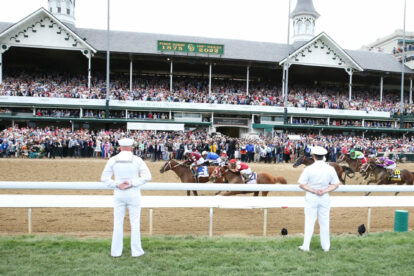The Kentucky Derby and the Epsom Derby are two of the most prestigious horse races in the world. Each stands as a cornerstone of its country’s racing calendar and sporting identity. While both serve as the centerpiece of its nation’s Triple Crown series, they differ in tradition, racing style, commercial impact, and global influence.
Triple Crowns: Tradition vs. Modern Racing
The Kentucky Derby, held each year on the first Saturday in May at Churchill Downs, kicks off the American Triple Crown, followed by the Preakness Stakes and the Belmont Stakes. Winning all three races is considered one of the sport’s rarest and most treasured accomplishments; only 13 horses have completed the sweep, starting with Sir Barton in 1919 and most recently Justify in 2018.
The Epsom Derby, run every June at Epsom Downs in England, serves as the second leg of the British Triple Crown, sandwiched between the 2000 Guineas and the St Leger Stakes. The British version tests a wider range of attributes over different distances, from one mile to nearly one mile and six furlongs. But the challenge is now rarely attempted due to modern breeding trends and commercial pressures. Nijinsky remains the last horse to win all three, back in 1970. The most notable near-miss came in 2012, when Camelot won both the Guineas and the Derby but finished second in the St Leger on soft ground.
Betting Revenue: A Clear Divide
In terms of betting handle, the Kentucky Derby is in a league of its own. The 2024 Derby day card brought in more than $280 million in total wagers, with nearly $190 million bet on the main event alone. Thanks to widespread simulcast coverage and online access, it stands as one of the most lucrative single-day betting events in all of sports.
The Epsom Derby, while immensely popular in the UK and globally respected, draws more modest figures. According to the free bets and UK horse racing experts at betting.bet, the worldwide handle on Derby day typically reaches around £100 million (approximately $130 million USD), with much of that coming from domestic and European bettors. Though smaller in scale, it remains a fixture for international players and elite racing stables.
Crowds and Viewership
Both events are massive spectacles, though their flavors differ. The Kentucky Derby brings in over 150,000 spectators to Churchill Downs, making it the most heavily attended horse race in North America. In 2023, the NBC broadcast drew over 14 million viewers, a few sporting events outside the NFL can match.
The Epsom Derby, by comparison, often attracts 100,000 or more fans, many of whom gather on the infield (known as The Hill) in a long-standing public tradition. In the UK, television audiences for the race typically range from 2 to 4 million, and the event remains a staple of the British summer social and sporting calendar.
History and Hall of Fame Winners
The Epsom Derby is the older of the two, having first been run in 1780. It is the original “Derby”, the race from which all others, Kentucky included, take their name. Its roll call of winners includes some of the greatest horses in turf history: Sea-Bird, Nijinsky, Galileo, Shergar, Sea The Stars, and Workforce, among others. Sea-Bird’s effortless 1965 win is still spoken of in reverent tones, while Sea The Stars’ 2009 Derby victory was part of a season that also included wins in the 2000 Guineas and the Arc de Triomphe.
The Kentucky Derby, first contested in 1875, may be younger, but it’s arguably the most famous horse race in the world. Legends like Secretariat, American Pharoah, Justify, and Citation have all triumphed in the Run for the Roses. Secretariat’s 1973 win remains iconic, not only for its sheer dominance, but because his final time of 1:59.40 still stands as the fastest in Derby history. His influence continues to loom large: every single horse in the 2025 Kentucky Derby was a descendant of Secretariat, a powerful reminder of his legacy.
Surface and Style: Dirt vs. Turf
The Kentucky Derby is run over 1¼ miles on dirt, a surface that prioritizes early speed, stamina, and tactical positioning, hallmarks of American-style racing. Track conditions and gate draw can heavily influence outcomes, and sharp fractions out of the gate are often decisive.
The Epsom Derby, on the other hand, is contested over 1½ miles on turf, on one of the most challenging tracks in the world. Epsom’s steep downhill run, camber, and undulating layout demand balance, agility, and a strong finishing kick. It’s a course that separates raw talent from true thoroughbred class.
Cultural Importance and Global Reach
The Kentucky Derby is a full-blown American cultural event. Nicknamed “The Most Exciting Two Minutes in Sports,” it is broadcast nationwide, covered heavily in lifestyle and entertainment media. It features everything from mint juleps and celebrity fashion to infield parties and Southern pageantry. It’s more than a race, it’s an institution.
The Epsom Derby, while equally revered in racing circles, retains a more traditional and aristocratic identity. It’s often attended by royalty and remains a key date in the British social calendar. Though it doesn’t attract the same level of mainstream media buzz as the Kentucky Derby, it’s still regarded as one of the most important turf races on the international calendar.
Legends in Their Own Right
The Kentucky Derby and the Epsom Derby may differ in surface, style, and setting, but both represent the pinnacle of flat racing. One is the embodiment of American speed and spectacle, and the other is a true test of turf excellence and thoroughbred endurance.
From Secretariat to Sea The Stars, from Churchill Downs to Epsom Downs, these two great races continue to define legacies, thrill millions, and remind us why horse racing, at its best, is a sport like no other.


